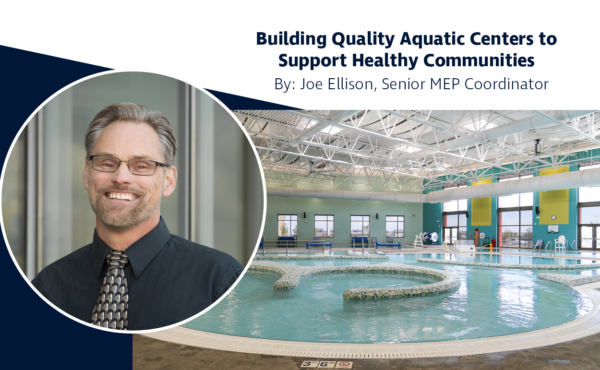Communities across Colorado consistently remain ranked as the healthiest places to live in the U.S. — mainly because of their outdoor and indoor recreation amenities. Saunders Construction serves as a valuable partner to both public and private clients across the Front Range on parks, recreation and athletic facility projects — many of which incorporate aquatic features for patrons to enjoy. Over the past 50 years, Saunders has completed over 85 sports and recreation facilities with more than 20 aquatic centers included.
Indoor swimming facilities, also defined as natatoriums, propose many unique challenges to the construction industry, especially as it relates to the mechanical, electrical and plumbing (MEP) systems that serve them. There are many things to consider when preplanning the construction of a natatorium, including the layout of the air distribution system, the controls associated with the indoor pool HVAC systems, and the unique temperature, humidity and pressure requirements of the space. It is imperative these MEP systems are installed properly and fully tested to ensure pool odors are contained, the space is comfortable for patrons, and condensation is mitigated. Condensation can be especially pernicious since the chlorinated water which has evaporated can condense on surfaces and cause corrosion. With that said, below are a few important items to consider when reviewing the design, installation, and final documentation as it relates to these systems on an indoor aquatic center project.
Natatorium Construction
- Vapor barriers must be installed to enclose the pool envelope walls and ceilings.
- Supply air discharge “washes” the windows with relatively warm air to mitigate excess condensation on exterior windows during cold weather.
- Locate the return air to the pool air handling unit away from the supply air distribution to maximize airflow throughout the space.
Natatorium Environment Control
Pool environment maintenance and control is important as pool water is constantly evaporating. The amount of evaporation is affected by pool size and temperature. There are several ways evaporation can be controlled, many of which, are directly related to the indoor pool HVAC systems.
System Commissioning
Ensure the test and balance contractor works with the temperature control contractor, and the pool air handling unit provider to commission the system through all phases of operation, including heating, cooling and the pool dehumidification of the swimming facility. This will be validated by the start-up documents, controls system paperwork, and the test and balance report. It’s important to receive these documents upon completion as confirmation this has been done prior to final commissioning by the third-party commissioning provider.
Media Contact
Teena Bergstrand
Vice President of Market Strategies and Communication
(303) 699-9000
m.inquiries@saundersinc.com
